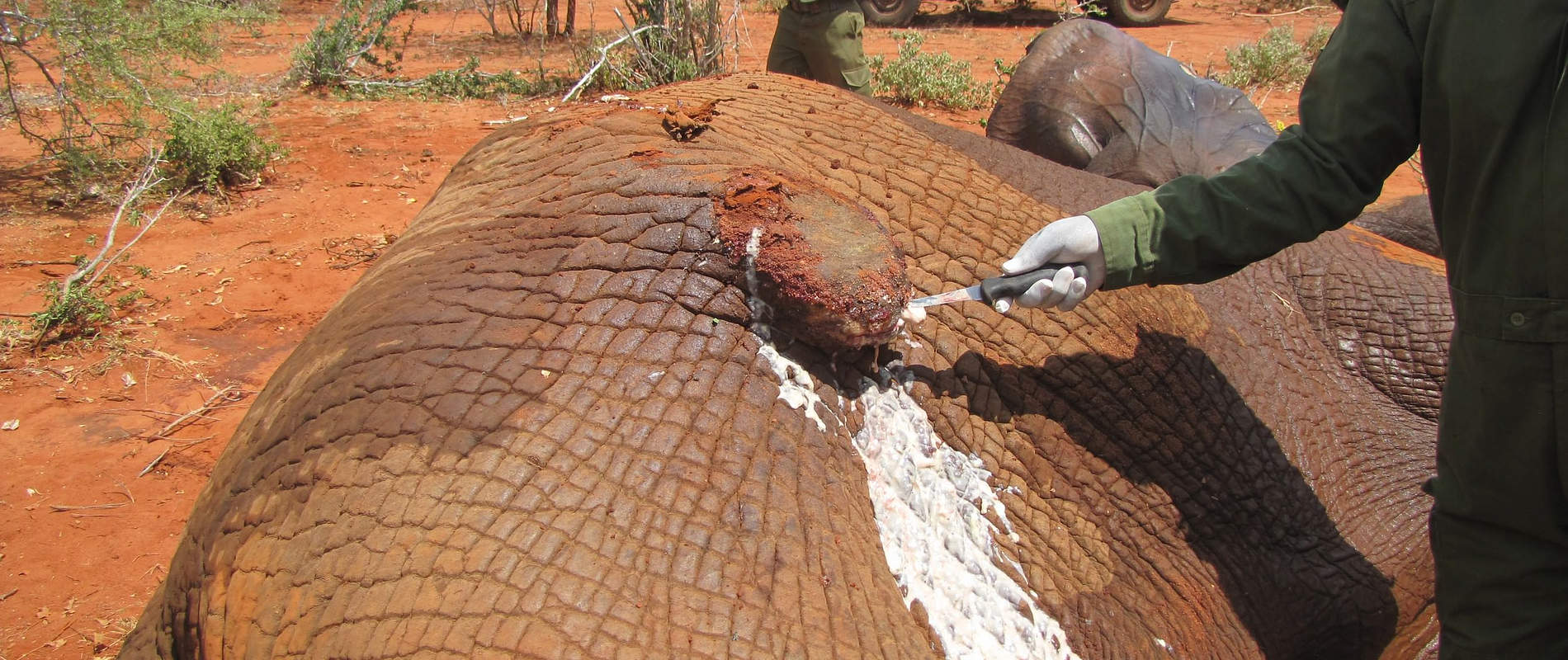FIELD VETERINARY REPORT FOR TSAVO MOBILE VET UNIT FOR THE MONTH OF JANUARY 2017 After being away on annual leave in the month of December the Tsavo unit resumed duties in mid-January with few cases handled before the Month to an end
FIELD VETERINARY REPORT FOR TSAVO MOBILE VET UNIT FOR THE MONTH OF JANUARY 2017
After being away on annual leave in the month of December the Tsavo unit resumed duties in mid-January with few cases handled before the Month to an end. This included treatment and supplementation of an injured young lion in pipeline area of Tsavo east, treatment of an Elephant with arrow wound injury at KMC ranch near Rukinga, snare removal of a Buffalo near Sarova salt lick sanctuary and treatment of an Elephant cow with an arrow injury of the front limb near Tiva River in Tsavo east. A giraffe with a snare near Sarova was not found even after hours of searching. Tsavo ecosystem is still green and no case of starvation was observed as compared to November last year.
Reported by Dr Jeremiah Poghon
CASE#1 TREATMENT OF AN INJURED LION
Date of intervention: 22nd January
Animal: African lion
Sex: Male
Age: Sub Adult
Location: Mzima pipeline, Tsavo east
History
The lion was reported to be in a pride of 5 others with an injury to the neck and the eye. He was treated previously for injuries caused by a buffalo attack.
Immobilization, examination and treatment
The lion was immobilized with 100 mgs of Ketamine and 2 mgs of Meditomidine. It took about 5 minutes for the lion to be fully immobilized and a vehicle was used to push the pride away. The lion was then moved under shade for examination. The gaping wound that cut through the skin and muscles was cleaned using tincture of iodine and sprayed with Oxytetracycline spray. Any open wounds were sutured closed and then covered with green clay to aid the healing process and protect the wound from dirt.


The lion was also administered with 15 cc of long acting Amoxicillin and dexamethasone parenterally.
Reversal and Prognosis
The Lion was revived using 2.5 mgs of Atipemazole. He was supplemented with 5 kgs of beef on bone as he was very weak. Further follow up indicated great improvement.
CASE#2 TREATMENT OF AN INJURED ELEPHANT BULL
Date: 28th January 2016
Species: Elephant
Sex: Male
Age: Adult (About 30 years)
Location: KMC ranch, Tsavo
History
This elephant bull was spotted by Rukinga patrol aircraft near the KMC ranch area with an arrow wound to the right abdominal flank with blood oozing out. The team rushed to the area to find the bull with another elephant drinking water in a nearby dam.
Immobilization, examination and treatment
A dan-inject dart was prepared with 18mgs of Etorphine and loaded into a dan-inject dart gun. However, the elephant ran away at every attempt to approach on foot or by vehicle so the assistance of the DSWT chopper was sought. The elephant was darted from the helicopter and it took him 7 minutes to go down on lateral recumbency of the right side. He was rolled over for treatment using ropes tied to a landcruiser.
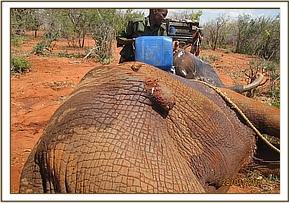

Examination revealed a septic wound full of pus. The lowest side of the wound was opened and necrotic tissues plus pus drained. The area was then cleaned using water mixed with Hydrogen peroxide, tincture of iodine and then Oxytetracycline spray applied. Finally the wound was covered with wetted green clay.
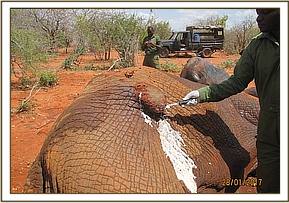

An intravenous administration of 50 cc Dexamethasone Hcl was given through the ear vein and 200 cc of long acting Amoxicillin injected intramuscularly.
Reversal and Prognosis
Drug reversal was done by administration of Diprenorphine Hcl at three times the Etorphine dose. He stood up and walked away calmly. Prognosis is good.
CASE#3 DESNARING OF A BUFFALO
Date: 30th January
Species: Buffalo
Sex: Male
Age: Adult
Location: Taita salt lick sanctuary
History
A report was received from the DSWT de-snaring team of a buffalo with a tight wire snare around the neck near Salt Lick Wildlife Sanctuary. The team rushed into the area to find the snared buffalo under a tree with three other bulls.
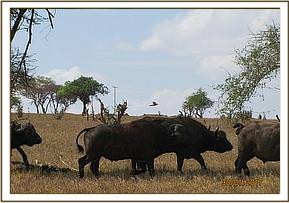

Immobilization, examination and treatment
The buffalo was immobilized using 9 mgs of Etorphine mixed with 70 mgs of Xylazine and it went down in 5 minutes. The strong wire snare was removed from the neck leaving only small neck wounds. The buffalo was administered with Dexamethasone Hcl and a long acting antibiotic parenterally.
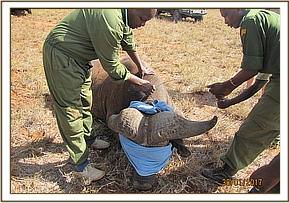

Reversal and Prognosis
The anaesthesia was reversed using Diprenorphine at three times the Etorphine dose and 0.5cc of Atipemazole Hcl both IV through the jugular vein. The buffalo woke up and joined the others. Prognosis is good.
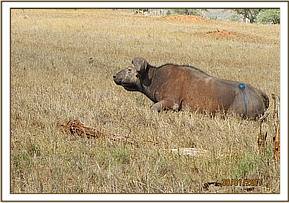

CASE#4 TREATMENT OF AN INJURED ELEPHANT COW
Date: 31st January 2017
Species: Elephant
Sex: Female
Age: Adult (About 30 years)
Location: Tiva River, Tsavo east
History
This elephant cow was seen by DSWT patrol aircraft near the Tiva River area with an arrow wound to the right abdominal flank with blood oozing out. The vet was airlifted by DSWT aircraft to the area and then boarded a helicopter to the site for easier darting.
Immobilization, examination and treatment
The elephant was darted from a helicopter using 18 mgs of Etorphine in a dan-inject dart. It took about 7 minutes for the drugs to take effect and it went down on left lateral recumbency. Ropes were tied to a vehicle to roll him over and expose the wound.


There was a septic wound with pus oozing out on the medial aspect of the right front limb near the fetlock joint. The injury was opened up so the necrotic tissues and pus could be drained out. The wound was then cleaned using water mixed with Hydrogen peroxide before applying tincture of iodine and Oxytetracycline spray. A final cover of wetted green clay was used to cover the wound.


An intravenous administration of 50 cc Flunixine meglumine was administered through the ear vein and 100 cc of long acting Amoxicillin injected intramuscularly.
Reversal and Prognosis
Drug reversal was achieved by administration of Diprenorphine Hcl at three times the Etorphine dose. She stood up and walked away calmly. Prognosis is guarded.
Other cases handled by the unit
- The unit was called in for a snared Giraffe in Salt lick sanctuary but even after extensive search it was not located.
Acknowledgement
We are grateful for the Amboseli vet unit for holding brief when the unit was away on annual leave during the month of December.
The unit also appreciates the support of its sponsors ViER PFOTEN through the David Sheldrick Wildlife Trust (DSWT) for their immense financial contribution to the unit. We also thank Kenya Wildlife Service through the Assistant director Tsavo conservation area and the head, veterinary and capture services department for their support.
